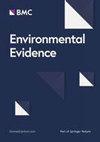让放牧动物获得额外营养源对半天然牧场生物多样性的影响:系统综述
IF 5.2
4区 环境科学与生态学
Q2 ENVIRONMENTAL SCIENCES
引用次数: 0
摘要
传统管理的半天然牧场因其高度的生物多样性而受到认可。其缺点是,这些牧场的饲料产量往往很低,因此利润很低,可能会导致牧民放弃放牧。提高产量和盈利能力并维持放牧的两种方法是:(i) 向放牧者提供补充饲料,或 (ii) 将半天然牧场与改良牧场共同封闭。这两种做法都可能将养分转移到半天然牧场,对生物多样性造成潜在的负面影响。本系统综述旨在分析有关以下主要问题的现有证据:"让放牧者获得额外的营养源对半天然牧场的生物多样性有何影响?(Q1).我们还使用了两个辅助问题:"让放牧者获得更多营养源对半天然牧场土壤养分状况有何影响?"(问题 2)和 "半天然牧场的食草动物在获得额外养分来源时表现如何?(Q3).利用书目数据库、搜索引擎、专业网站和利益相关者的联系方式搜索同行评议文献和灰色文献。根据预先确定的资格标准筛选相关文献,并使用 CEECAT 工具进行批判性评估。相关研究的数据库已编制完成。有关证据基础的描述性信息以表格和交互式证据图谱的形式呈现。由于缺乏重复研究的设置,因此没有对 Q1 和 Q2 进行定量分析。不过,由于样本量较大,因此可以使用混合模型对 Q3 进行定量分析,即 (i) 共同围栏改良牧场对放牧者选择改良区域的影响,以及 (ii) 补充饲料对放牧者草料摄入量的影响。共有 12 篇关于补充饲料影响的文章和 19 篇关于共同圈养改良草场影响的文章被收录,其中一些文章针对多个综述问题。由于文献有限,因此无法就半天然牧场对生物多样性(Q1)或营养状况(Q2)的影响得出任何结论。就 Q3 而言,有 28 项研究符合我们的标准,其中 18 项研究调查了放牧者在共同圈养改良草场时的行为,10 项研究调查了放牧者在获得补充饲料时的饲料摄入量。结果表明,除山羊外,所有食草动物都喜欢在改良区域放牧,无论它们是否与其他食草动物一起放牧。我们发现,补饲对食草动物的饲料摄入量没有影响。我们发现在两种额外营养源对半天然牧场生物多样性(Q1)和营养状况(Q2)的影响方面存在知识空白,因此需要进一步研究。对 Q3 的分析表明,与半天然草场相比,食草动物更喜欢在改良草场上吃草。然而,这种行为如何影响养分输送和生物多样性尚不清楚,也无法转化为管理建议。为了更好地了解我们综述的首要问题,需要开展专门针对这一问题的研究。我们将就如何设计此类研究提出建议,包括时空设置以及需要考虑的关键管理和环境条件。本文章由计算机程序翻译,如有差异,请以英文原文为准。
Effects on biodiversity in semi-natural pastures of giving the grazing animals access to additional nutrient sources: a systematic review
Traditionally managed semi-natural pastures are recognised for their high biodiversity. One drawback is that these pastures are often low in fodder production and hence rather unprofitable, which may lead to abandonment. Two ways to increase production and profitability and maintain grazing are to (i) offer the grazers supplementary feed, or (ii) co-enclose the semi-natural pasture with an improved pasture. Both practices may transfer nutrients to the semi-natural pasture, with potential negative effects on biodiversity. This systematic review aimed to analyse the available evidence concerning the following primary question: “What is the effect of giving grazers access to additional nutrient sources on biodiversity in semi-natural pastures?” (Q1). We also used two supporting questions: “What is the effect of giving grazers access to additional nutrient sources on nutrient status of the soils of semi-natural pastures?” (Q2) and “How do the grazers of semi-natural pastures behave while having access to additional nutrient sources?” (Q3). Searches for peer-reviewed and grey literature were made using bibliographic databases, search engines, specialist websites, and stakeholder contacts. Literature was screened for relevance according to predefined eligibility criteria, and critical appraisal was performed using the tool CEECAT. A database of the relevant studies was compiled. Descriptive information about the evidence base is presented in tables and an interactive evidence atlas. Because of absent study setup replication, Q1 and Q2 were not analysed quantitatively. However, sample size allowed the use of mixed modelling to quantitatively analyse Q3 regarding the effects of (i) co-enclosing an improved pasture on grazers’ electivity for the improved area, and (ii) supplementary feed on the forage intake of grazers. A total of 12 articles on the effects of supplementary feeding and 19 on the effects of co-enclosing an improved pasture were included, of which some targeted multiple review questions. Because of the limited literature, it is not possible to draw any conclusions concerning the effects on biodiversity (Q1) or nutritional status (Q2) in semi-natural pastures. For Q3, 28 studies fulfilled our criteria, of which 18 investigated the behaviour of grazers related to co-enclosing an improved pasture, and 10 investigated their forage intake while having access to supplementary fodder. The results show that all grazer species except goats preferred grazing in the improved areas regardless of whether they were grazing together with other grazer species or not. We found no effect of supplementary feeding on forage intake of the grazers. We detected a knowledge gap concerning the effects of the two additional nutrient sources on semi-natural pasture biodiversity (Q1) and nutrient status (Q2), which points toward further research needs. Analysis of Q3 showed that grazers prefer to graze improved compared to semi-natural pasture areas. However, how this behaviour subsequently affects nutrient transport and biodiversity is unclear and cannot be translated into management recommendations. To gain better knowledge about the primary question of our review, research focusing specifically on this question is needed. We provide suggestions for how such studies could be designed, including spatio-temporal setup, and key management and environmental conditions to consider.
求助全文
通过发布文献求助,成功后即可免费获取论文全文。
去求助
来源期刊

Environmental Evidence
Environmental Science-Management, Monitoring, Policy and Law
CiteScore
6.10
自引率
18.20%
发文量
36
审稿时长
17 weeks
期刊介绍:
Environmental Evidence is the journal of the Collaboration for Environmental Evidence (CEE). The Journal facilitates rapid publication of evidence syntheses, in the form of Systematic Reviews and Maps conducted to CEE Guidelines and Standards. We focus on the effectiveness of environmental management interventions and the impact of human activities on the environment. Our scope covers all forms of environmental management and human impacts and therefore spans the natural and social sciences. Subjects include water security, agriculture, food security, forestry, fisheries, natural resource management, biodiversity conservation, climate change, ecosystem services, pollution, invasive species, environment and human wellbeing, sustainable energy use, soil management, environmental legislation, environmental education.
 求助内容:
求助内容: 应助结果提醒方式:
应助结果提醒方式:


